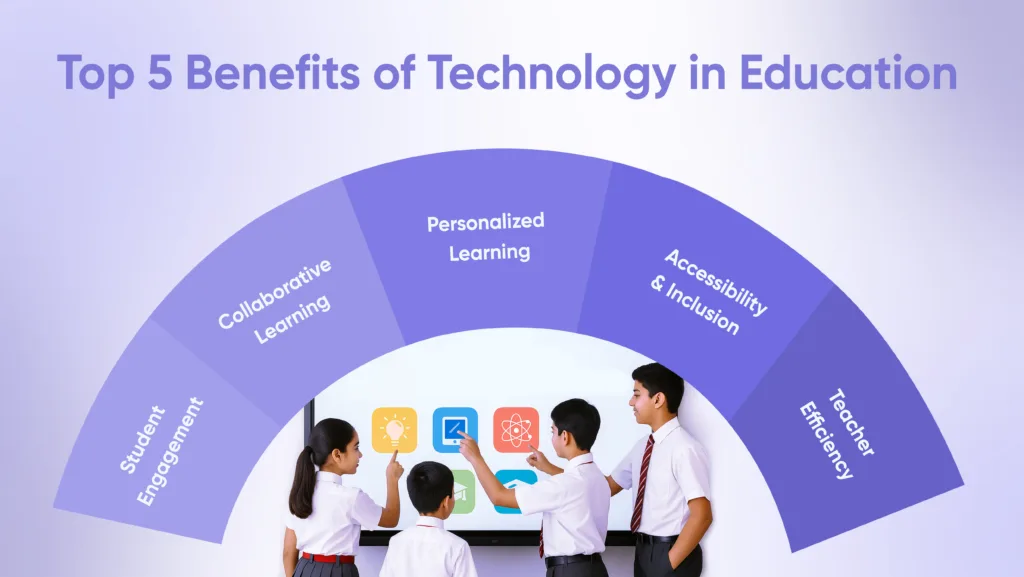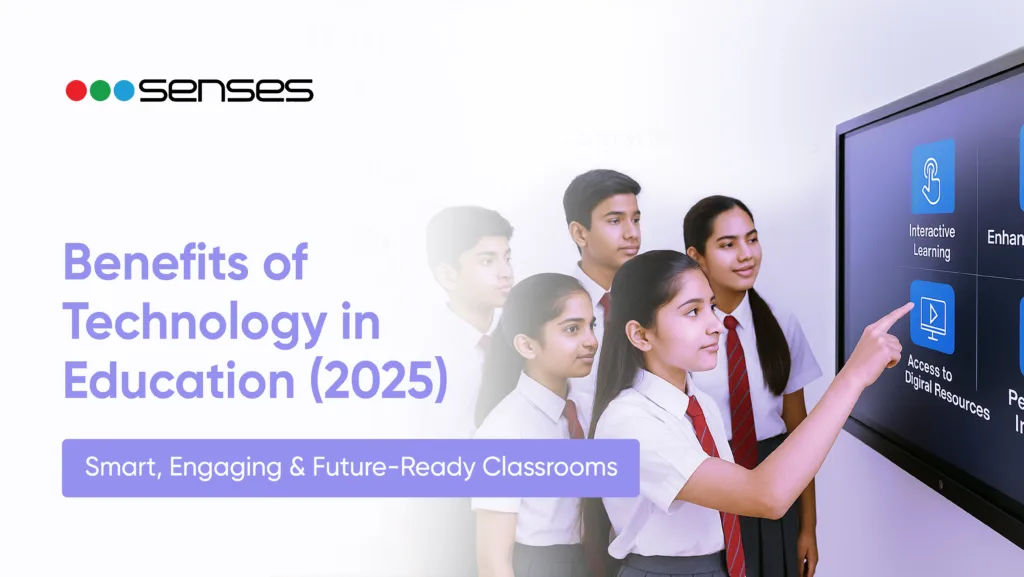Technology in education is no longer just an add-on tool; it’s becoming part of the core elements of teaching and learning in contemporary times. Classrooms are rapidly emerging from divergent types of educational technologies, such as smart boards, interactive panels, adaptive learning technologies, and online platforms.
Educational institutions around the world are unleashing the potential of technology in education to enrich the participation in learning that is engaging, inclusive, and effective.
In this blog, we will explore the values of technology in education, address the challenges of learning in that environment, and learn about Senses Electronics’ role in transforming the future of smart classrooms.
What is Technology in Education?
Technology in education means using digital tools, platforms, and devices to support teaching and learning. It extends beyond computers to technologies in K-12 settings, including smart boards, interactive panels, edtech platforms, online assessment tools, and collaborative learning environments.
The driving force behind the purpose is to make education more interactive and personalized than in the past, while supporting more equitable access. Schools that embrace educational software and hardware can teach students the digital competencies for future workforces while improving the overall engagement of learning.

Advantages of Technology in Education
Technology provides multiple benefits to the classroom, which can lead to greater outcomes for educators and learners alike. Let’s take a look at some of the benefits of technology in education.
1. Increases Engagement for Students
When learning through video, simulations, or, for instance, interactive quizzes, students are often more engaged. It has been increasingly found that gamification in education improves motivation by converting lessons to challenges and tasks that are reward-based.
2. Fosters Collaboration
Collaborative technologies allow students to work in groups, whether the learning happens in the same physical classroom or in a remote setting. Collaborative presentation tools such as smart boards and interactive flat panel displays promote collaboration and increased engagement from students.
3. Increases Teacher Efficiency
For educators, goals for digital literacy training, online assessment tools, and blended learning will ultimately lessen educator workload. For example, a smart board allows a teacher to present lessons usefully and saves time and effort.
4. Ensures Customized Learning
Adaptive learning technologies can customize educational content to each student’s particular learning speed accordingly. These technologies ensure that students who are impatient or fast learners face sufficient trouble, and students who are slow learners receive some support.
👉 Want to make your classroom more engaging? Explore Senses Electronics’ range of interactive flat panels designed for schools and colleges.
Role of EdTech Platforms in Education
Education Technology (EdTech) platforms provide digital means for teachers and students to connect for learning. These are important in public and private schools and colleges.
- Learning Management Systems (LMS): These are platforms such as Google Classroom or Moodle that house lessons, assignments, and feedback, so that everything is in one place for the instructor and students.
- AI-Powered Tools: AI assists as adaptive learning tools that can pinpoint placement into a lesson, as well as question/answer with chatbots. It can provide the instructor with valuable real-time data as well.
Data Analytics in Education: Schools are able to monitor attendance, grades, and performance trends. Monitoring, educators can work directly to tutor weak areas and provide additional support to struggling students

Benefits of Technology in the Classroom Setting
Classroom instruction has changed as a result of educational technology. Here’s how new tools function inside the classroom.
| Visual Learning with SMART Boards | A SMART Board for teaching lets teachers create lessons using diagrams, 3D models, and videos, which make lessons easier to understand. Quality visuals help students to better understand information for topics such as maths or science. |
| Live & Hybrid Learning Made Simple | With large touchscreen TVs and interactive flat panels, students can join lessons from around the world. Blended learning is a model that combines online learning with in-person learning. In blended learning, educators can develop lessons without seat time restrictions. |
| Equity in Learning | Assistive technology in the special education classroom ensures all students in the classroom have learning participation opportunities. For example, screen readers, voice-to-text software, and accessible interactive panels from Senses Electronics all promote equitable learning opportunities. |
Future of Technology in Education
The future of education is being shaped by innovation. Here’s what to anticipate.
1. AI & Virtual Reality Classrooms
In classrooms, learners can explore virtual labs, visit historical sites, or discover scientific concepts by using virtual & augmented reality. Such tools will allow students to connect learning to their own experiences in an immersive environment, which enhances long-term memory storage.
2. Gamified Assessments
Gamification in education will continue to expand, reframing quizzes and tests into interactive activities. This will create excitement and reduce test-related stress while motivating students toward the desired learning results.
3. Cloud-Based Learning
Learning cloud-based platforms will change learning organisations, allowing students to access learning materials anywhere and anytime. This will support collaborative learning technologies and provide digital storage and student tracking over the long term.
4. Preparing Future Workforce Digital Skills
As technology becomes the driving force behind organisations and businesses, students need future workforce digital skills. Schools equipped with smart boards and interactive panels (provided by Senses Electronics) are preparing students for digital futures.

Why Schools and Colleges Choose Senses Electronics
Senses Electronics is a trusted name in smart classroom solutions.
- Smart boards, interactive flat panels, and LED displays built for the modern-day teacher.
- Over 9,000 schools and over 100,000 classrooms in India have implemented Senses Electronics smart solutions.
- Products that are well priced, durable and easy to use.
- Designed to foster inclusive education in both small and large classrooms and are scalable too.
Conclusion
The advantages of technology in education go well beyond convenience; they create improvements in engagement, inclusion and future readiness. Technology has transformed the way students learn and teachers teach, such as smart boards for teaching, adaptive learning tools and collaborative platforms.
The schools that take on solutions from Senses Electronics not only benefit from the latest and greatest teaching tools, but also ensure that their students are prepared with the skills necessary for the future. Now is the time to use technology to advance the future of education!
FAQs
Technology helps teachers save time and get better results while maintaining personalised, accessible, and engaging learning.
It simplifies complicated topics, motivates collaboration, and provides access to worldwide information.
Assistive technologies such as text-to-speech and interactive exhibit panels enable students with different needs to experience equal access and opportunity.
Yes, while there are large initial costs, the benefits in the long run for improved learning outcomes and time savings are significant and cost-effective.

